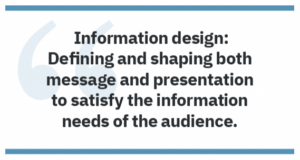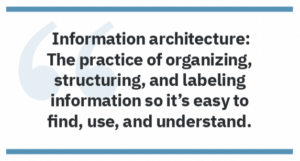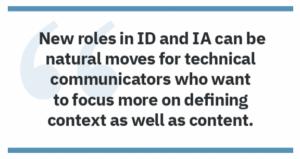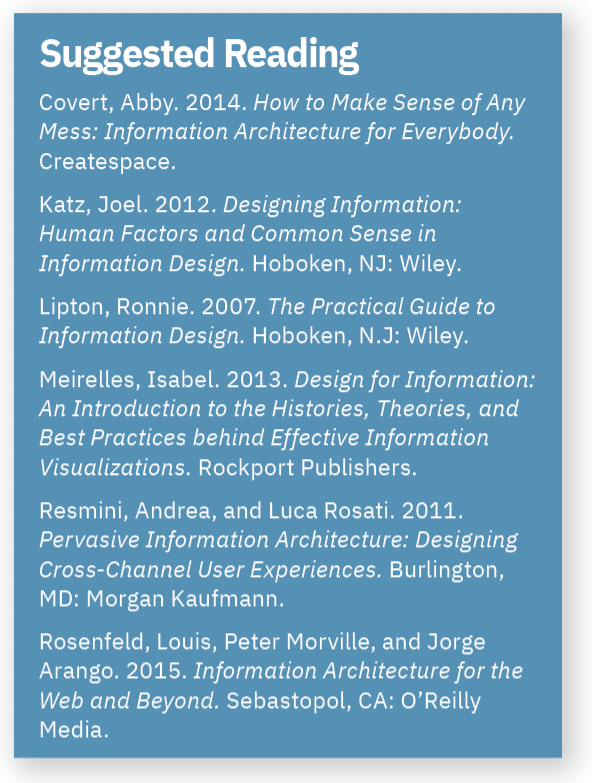By Guiseppe Getto | STC Member and Christina Mayr | STC Member
Information design and information architecture provide opportunities for career growth for technical communicators interested in the audience-driven design, organization, and structure of content.
As a technical communicator, your career options are wide open. You may have begun your career as a technical writer only to move into technical editing. Or you may have followed your passion into a related field like content strategy, UX, or marketing. A quick look through the STC’s Job Bank, or a job search engine like Indeed, will reveal the true diversity of roles that involve the effective communication of technical information.
During your journey through this field, you may have also encountered two less-understood roles: that of the information designer and information architect. In our experience as two people interested in the effective design, architecting, and deployment of information, you’re probably confused by what these roles entail, especially if you’ve never worked in one of them. You may have even seen them used interchangeably by other practitioners or in job ads. And you may be justifiably confused as to the differences between these two roles, what they involve, and how they’re related.
In truth, information design (ID) and information architecture (IA) are fields in their own right with their own professional societies, skill sets, best practices, and roles within organizations. At the same time, as with many roles that involve the effective communication of information, they are also roles that technical communicators can move into if their interests take them in that direction. To help you better understand these fields, below we review the scope of each, their associated skill sets, and where to learn more.
Defining Information Design and Information Architecture
 If you search online for the term “information design,” you’ll find many different definitions, examples, and explainer articles. You’ll quickly realize the term seems to entail everything from visualizing data to creating complex graphics. The International Institute for Information Design defines information design as “the defining, planning, and shaping of the contents of a message and the environments in which it is presented, with the intention of satisfying the information needs of the intended recipients.”1 Though many definitions for ID exist, this one is representative of several common elements, namely that the field:
If you search online for the term “information design,” you’ll find many different definitions, examples, and explainer articles. You’ll quickly realize the term seems to entail everything from visualizing data to creating complex graphics. The International Institute for Information Design defines information design as “the defining, planning, and shaping of the contents of a message and the environments in which it is presented, with the intention of satisfying the information needs of the intended recipients.”1 Though many definitions for ID exist, this one is representative of several common elements, namely that the field:
- Involves planning as well as design
- Involves the development of content as well as the environment in which it appears
- Is driven by the needs of an audience
The field dates back to the 1980s2 when researchers in academia first began publishing work that investigated how information should be designed within a specific format rather than being simply presented to an audience. And, of course, the way information is presented to audiences has changed dramatically during the intervening four decades.
 If you search for “information architecture,” you’ll also find many definitions and examples for this field. You’ll learn that this field has close ties to something called “data architecture,” which is used in IT, and is also used in the development of complex websites. The Information Architecture Institute defines the field as “the practice of deciding how to arrange the parts of something to be understandable.”3 A better definition, which combines multiple sources, is: the practice of organizing, structuring, and labeling information so that it is easy to find, use, and understand (both in the real world and online).
If you search for “information architecture,” you’ll also find many definitions and examples for this field. You’ll learn that this field has close ties to something called “data architecture,” which is used in IT, and is also used in the development of complex websites. The Information Architecture Institute defines the field as “the practice of deciding how to arrange the parts of something to be understandable.”3 A better definition, which combines multiple sources, is: the practice of organizing, structuring, and labeling information so that it is easy to find, use, and understand (both in the real world and online).
Richard Saul Wurman coined the term “information architecture” at an American Institute of Architects conference in 1976 and published the first IA book a year later. Wurman believed information design was about how information looked rather than how it is accessed and used. Wurman’s astute observation neatly encapsulates the idea that IA is about creating systems of information rather than the delivery of information from within that system.4
Information Design and Information Architecture in Practice
Similar to related fields such as UX, content strategy, graphic design, and instructional design, information design is loosely organized and involves many professions and forms of practice. Arguably, any professional who is responsible for planning the implementation of information within a specific environment is using some elements of information design. At the same time, there does seem to be more of a focus on the design of specific kinds of information, such as data visualizations, infographics, maps, and interactive guides, rather than on the overall environment in which information is housed, such as websites, content management systems, or social media networks.
Information architecture also incorporates principles and practices from different professions. The biggest connections between IA and technical communication revolve around DITA, single-sourcing, and multi-channel publishing. But IA is really about order, structure, hierarchy, and, above all, efficiency. Efficiency of finding information and the connections between different systems that house usable data. Efficiency for writers, translators, and content operations staff. And, of course, efficiency for the end-users. Information architects simultaneously maintain holistic and detailed views of all published content within their control, planning the most likely paths to success for both sides of the screen.
Like ID, the work involved in IA is largely driven by the needs of the audience but focuses on streamlining access to and the functions of information rather than the final presentation. While it is true that some IAs do work on the presentation of content, it is not traditionally their purview. Where IAs and IDs align is that they both work to deliver the best content experiences for everyone involved, regardless of the format this content appears in.
Associated Skill Sets
Reviewing books and articles in information design reveals a wide-ranging list of associated skill sets. Many of these skills overlap related fields. They include, but aren’t limited to:
- Visual design
- Usability
- Typography
- Color design
- Layout design
- Document design
These skills are typically employed in a wide range of environments, from working for a textbook publisher to creating interactive graphics on a website to helping a news agency present data to its audience across various channels.
Information architects generally work in enterprise-level content areas that deliver content for multiple products in a variety of outputs. IA draws from a variety of information- and technology-related disciplines, such as:
- Library science
- Front-end web development (such as HTML and CSS)
- Back-end web development (such as WordPress and Drupal)
- Database management and design
- Structured authoring, such as XML and DITA
Like information designers, information architects work in a range of industries, from healthcare to education. We’ve also seen technical communicators moving into architecture roles as they move from the creation of content to the managing of large-scale content across an entire organization or product.
Moving into Jobs in Information Design and Information Architecture
 Information designers often find jobs as graphic designers, web designers, or instructional designers, among other professions. They are people who are talented at not only design but at understanding the needs of users for a specific type of design (e.g., designing a flowchart for a medical procedure represented in a brochure so patients can understand what their recovery will be like). They are competent in visual design but also understand that all information must be appropriate to its context and intended environment.
Information designers often find jobs as graphic designers, web designers, or instructional designers, among other professions. They are people who are talented at not only design but at understanding the needs of users for a specific type of design (e.g., designing a flowchart for a medical procedure represented in a brochure so patients can understand what their recovery will be like). They are competent in visual design but also understand that all information must be appropriate to its context and intended environment.
Information architects organically emerge as an organization’s content gets more complex. Their roles often grow out of supporting technology that needs more orchestration and governance, such as a complex authoring tool or content management system. The organization realizes they need an employee who does not also have to write and deliver content, but rather to shape the entire system in which that content lives. The vast majority of information architects transition into the role from content development roles (i.e., technical writing, web development and design, UX, library science) or, less frequently, software development roles. Professionals can move into information architecture work by researching and continuing their studies in user research, metadata, taxonomy, and industry-specific technologies supporting the content publishing pipeline.
Teaching, and Learning About, Information Design and Information Architecture
Professionals seeking to teach or train information designers should consider introducing learners to practices associated with the design process. This can include the process of assessing user needs, developing wireframes and prototypes, testing the prototype, and implementing it within a specific environment. It can also include best practices in design such as the appropriate use of contrast, alignment, proximity, repetition, and other elements.
Content professionals or managers training or teaching information architects should focus on teaching how to seek, define, and understand content and user problems at the deepest level; understanding the users themselves; and, finally, the more tactical aspects of IA: information organization, categorization — both within and outside digital confinement — and taxonomies.
Main Take-Away: Useful Fields with Many Opportunities
As you move through your technical communication career, you will doubtless encounter new opportunities to reskill, learn, and grow. You should strongly consider opportunities in information design and information architecture if you:
- Want to move from developing content to the design of content.
- Want to move from dealing primarily with audiences of technical documentation to dealing with users of information systems.
- Want to explore advanced publishing and information management options such as single-sourcing, multi-channel publishing, and the creation of complex websites
- Have a background in a related field such as UX or graphic design.
As we’ve mentioned throughout, many information designers and information architects are made, evolving into these roles from other professions. Looking around your current organization, as well as jobs available in the broader field, is probably the best way to start exploring the world of information, whether you want to become a designer or an architect.
References
- Egger, Robert. 2013. “International Institute for Information Design.” IIID. https://www
.iiid.net/idx-information-design-core-competencies/. - Pontis, Sheila. 2012. “20 Information Design Milestones.” 16 January 2012. https://sheilapontis
.com/2012/01/16/20-information-design-milestones/. - IA Institute. “What Is Information Architecture?” Accessed 1 March 2022. https://www
.iainstitute.org/what-is-ia/. - Wurman, Richard Saul. 1997. Information Architects. Zurich: Graphis.
 GUISEPPE GETTO (guiseppe@contentgarden.org) is an associate professor of technical and professional communication at East Carolina University and is president and founder of Content Garden, Inc. His research focuses on user experience (UX) design, content strategy, and participatory research with communities. Read more about him at: http://guiseppegetto.com.
GUISEPPE GETTO (guiseppe@contentgarden.org) is an associate professor of technical and professional communication at East Carolina University and is president and founder of Content Garden, Inc. His research focuses on user experience (UX) design, content strategy, and participatory research with communities. Read more about him at: http://guiseppegetto.com.
 CHRISTINA MAYR (christinaemayr@gmail.com) is the IT documentation lead at Epic Games. Much more than a technical writer, Christina has spent the last 10 years mentoring, teaching, and sharing her knowledge with others. Since graduating from East Carolina University with a master’s in technical and professional communication, Christina has worked as a technical writer, editor, or information architect in the pharmaceutical, state government, manufacturing, and hardware and software industries in central North Carolina. Whatever her title, Christina always aimed to simplify complex information and provide it when, where, and how users needed it.
CHRISTINA MAYR (christinaemayr@gmail.com) is the IT documentation lead at Epic Games. Much more than a technical writer, Christina has spent the last 10 years mentoring, teaching, and sharing her knowledge with others. Since graduating from East Carolina University with a master’s in technical and professional communication, Christina has worked as a technical writer, editor, or information architect in the pharmaceutical, state government, manufacturing, and hardware and software industries in central North Carolina. Whatever her title, Christina always aimed to simplify complex information and provide it when, where, and how users needed it.


